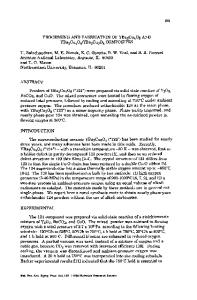Fabrication of YBa 2 Cu 3 O 7-x Filaments by Extrusion of a Cu 3 O 3 Ba 2 Y(meoEt) 7 (meoEt = 2-Methoxyethoxide) Precurs
- PDF / 1,000,725 Bytes
- 4 Pages / 420.48 x 639 pts Page_size
- 38 Downloads / 335 Views
FABRICATION OF YBa2 Cu.O 7 ., FILAMENTS BY EXTRUSION OF A Cu 3 O3 BaY(meOEt) 7 (meOEt = 2-METHOXYETHOXIDE) PRECURSOR
M.W. Rupich, S. F. Cogan, B. Lagos, and J. P. Hachey EIC Laboratories, Inc., Norwood, MA 02062 ABSTRACT YBa 2Cu 30 7 - filaments, with a zero resistance T, of 89.5 K and a Jc of 225 A/cm 2 in zero field at 77 K,were prepared from precursor filaments fabricated by extrusion of a polymeric Cu-Ba-Y precursor. The precursor was prepared by reaction of linear a (CuO)n polymer with Y and Ba alkoxides in non-aqueous solvents. Characterization of the precursor and superconducting filaments, along with the optimum extrusion and pyrolysis conditions, are described.
INTRODUCTION The development of high-Jc superconducting YBa 2Cu 3O7 .- filaments is the first step inthe fabrication of composite superconducting wire. In general, the J0's reported in filamentary YBa 2Cu 3O7T, have been too low for practical applications [1,2], although magnetization measurements on bulk material and thin films indicate that a low critical current is not an inherent material characteristic [3,4]. The major issues that must be addressed inthe development of high-Jc YBa 2Cu 30 7- filaments are: 1) crystallographic orientation of the YBa 2Cu 30 7- grains such that the high J, a-b planes are aligned parallel to the filament axis, 2) weak-link limited current transport across grain boundaries, and 3) the development of mechanical integrity. One method of promoting the alignment of the a-b planes of the YBa 2Cu 30 7.xalong the filament axis is to use a Cu-Ba-Y precursor containing a linear chain structure which can be aligned along the filament axis during the extrusion or drawing process. The synthesis of a linear Cu-Ba-Y precursor requires the formation of linear Cu-O-Cu-O chains that are isostructural with those in the orthorhombic YBa 2Cu 3O7.x. The formation of the required Cu-O-Cu bridges is not possible inaqueous media, since reaction with H20 results inthe formation of non-linear 2hydroxide bridges. However, in non-aqueous media, it is possible to prepare stable Cu ÷complexes containing linear Cu-O-Cu-O chains [5,6,7]. This paper reports on the synthesis, fabrication and characterization of YBa 2Cu 3O7.x filaments prepared by extrusion of a Cu-Ba-Y oxide alkoxide precursor. EXPERIMENTAL
The copper(ll) oxide polymer was prepared by the oxidation of a slurry of copper(l) chloride inpyridine by molecular oxygen according to reaction 1. The products of reaction 1 were separated by gel permeation chromatography using a Bio-Beads SX-8 resin with a pyridine eluant [6,7]. 4n CuCl+ n
02
-+ (CuO), +2n (pyr)2CuCl2
(1)
The Cu-Ba-Y precursor was synthesized by the reaction of (CuO)n with Ba(meOEt) 2 and Y(meOEt) 3 in pyridine or a pyrdine/2-methoxyethanol solvent mixture according to reactions 2 and 3 [8]. 3 (CuO), +2n Ba(meOEt)2 -4 n Cu3O3Ba2(meOEt)4 Cu3OBa2(meOEt)4 + Y(meOEt)3
--
Cu30,Ba2Y(meOEt)
Mat. Res. Soc. Symp. Proc. Vol. 169. ©1990 Materials Research Society
(2) (3)
1210
The Cu-Ba-Y precursor formed in reaction 3 was is
Data Loading...











